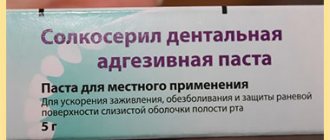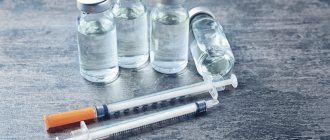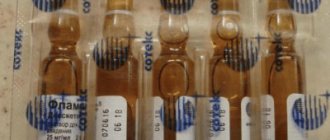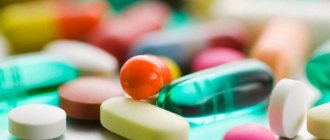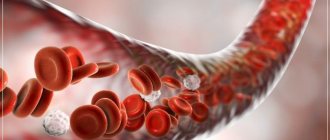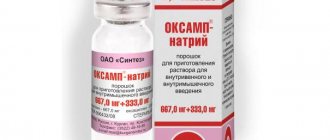We present to your attention Solcoseryl - instructions for the use of injections, the purpose and contraindications of the medication, and other useful information. The medicine is used externally and by injection in complex treatments.
This medical product is intended to improve metabolic processes, accelerate the supply of oxygen and glucose, and stimulate the restoration process within tissues.
By natural origin, Solcoseryl belongs to the biogenic group; the source for its production is blood taken from a calf and freed from proteins.
Compound
The solution for injection contains 42.5 mg/ml hemoderivate (extract) from calf blood as an active substance and water for injection (Aqua pro injectionibus) as an auxiliary component.
One gram of eye gel contains 8.3 g of active substance and auxiliary ingredients: sodium carboxymethyl cellulose (Sodium carboxymethyl cellulose), sorbitol (Sorbitol), water for injection (Aqua pro injectionibus), benzalkonium chloride (Benzalkonii chloridum).
One gram ointment contains 2.07 mg of active substance and a number of auxiliary components: methyl parahydroxybenzoate (E 218; Methyl parahydroxybenzoate), propyl parahydroxybenzoate (E 216; Propyl parahydroxybenzoate), cetyl alcohol (Cetyl spiritus), cholesterol (Cholesterol), white petroleum jelly ( Vaselinum album), water for injection (Aqua pro injectionibus).
One gram of jelly contains 4.15 mg of active substance and a number of auxiliary components: methyl parahydroxybenzoate (E 218; Methyl parahydroxybenzoate), propyl parahydroxybenzoate (E 216; Propyl parahydroxybenzoate), propylene glycol (Propylene glycol), carboxymethyl cellulose sodium salt (Sodium carboxymethyl cellulose), water for injection (Aqua pro injectionibus), calcium lactate pentahydrate (Calcii lactas pentahydrate).
pharmachologic effect
Solcoseryl is a medicine that affects mainly metabolic processes in tissues. They activate tissue metabolic processes , improve trophism and stimulate tissue repair and when exposed to damaging factors.
Solcoseryl in injection form belongs to the pharmacotherapeutic group “ Hemodialysates and hemofiltrates ”, ointment and jelly - to the category of drugs used to treat wounds and ulcers (including poorly healing ones), gel - to the category of drugs used to treat ophthalmological diseases .
Pharmacodynamics and pharmacokinetics
The main component of Solcoseryl preparations are fractions of the blood of calves with natural low-molecular substances included in their composition, the molecular weight of which does not exceed 5 thousand daltons.
To date, its properties have only been partially studied. In vitro tests, as well as preclinical and clinical studies, have shown that calf blood extract:
- promotes the restoration and/or maintenance of aerobic metabolism and oxidative phosphorylation processes, and also ensures the replenishment of cells that do not receive sufficient nutrition with high-energy phosphates;
- in vitro enhances the utilization of oxygen and activates the transport of glucose into tissues and cells hypoxia and ;
- helps improve repair and regeneration processes in damaged tissues that do not receive sufficient nutrition;
- prevents the development or reduces the severity of secondary degradation and pathological changes in reversibly damaged cells and cellular systems ;
- in in vitro models activates collagen synthesis ;
- has a stimulating effect on the proliferation (reproduction) of cells and their migration (in in vitro models).
Thus, Solcoseryl protects tissues that are in a state of oxygen starvation and nutritional deficiency, and accelerates the processes of their restoration and healing.
Solcoseryl eye gel is a dosage form that was developed specifically for the treatment of lesions with troma of the cornea .
The gel-like consistency of the product ensures its uniform distribution on the cornea , and good adhesive properties allow it to remain on it for a long period of time. The use of eye gel accelerates the restoration of damaged tissues and prevents scarring.
The rate and extent of absorption, distribution, as well as the rate and route of elimination of the active substance from the patient’s body cannot be determined using conventional pharmacokinetic methods, since protein-free calf blood extract has pharmacodynamic effects that are characteristic of molecules with different chemical and physical properties.
In the process of studying the pharmacokinetic characteristics of Solcoseryl solution in animals, it was found that after a bolus injection, the effect of the drug develops within half an hour. The effect lasts for three hours after administration of the solution.
Analogs (briefly)
Solcoseryl substitutes have similar compositions and properties:
- Curantil or Dipyridamole. Used to improve tissue microcirculation in the ischemic area, prevent platelet aggregation and vascular blockage. Gently expands capillaries, allowing cells to access oxygen and nutritional compounds. At the same time, the drug differs in the number of side reactions - there are more of them than with Solcoseryl. The therapeutic effect is lower.
- Actovegin. Increases metabolic rate, increases serum hemoglobin level, improves glucose uptake by cells. The therapeutic effect is observed 1.5 hours after the injection.
Solcoseryl is an effective, fast-acting remedy. The medicine has a lower risk of adverse reactions.
Indications for use
Solcoseryl injections: what are they for and what groups of patients are they prescribed for?
Solcoseryl in ampoules is indicated for patients who have been diagnosed with occlusive peripheral artery disease of the third or fourth degree according to the Fontaine classification and who have contraindications or intolerance to other vasoactive drugs .
It is also prescribed to patients with chronic venous insufficiency , which is accompanied by the formation of treatment-resistant trophic ulcers , as well as to patients with disorders of cerebral metabolism .
What is Solcoseryl ointment and jelly for?
The use of ointment and jelly is advisable for the treatment of minor injuries (for example, abrasions or cuts), frostbite, first and second degree burns (thermal or solar), difficult-to-heal wounds (for example, trophic skin disorders of venous etiology or bedsores ).
Indications for use of eye gel
Solcoseryl eye gel is recommended:
- for the treatment of mechanical injuries and erosive damage to the cornea and conjunctiva ;
- to accelerate the healing processes of postoperative scars in the postoperative period (for example, after a cornea transplant , surgery to remove a cloudy lens , surgical treatment of glaucoma , etc.);
- for the treatment of burns of the cornea of various origins (thermal, chemical or radiation);
- for the treatment of ulcerative lesions of the cornea and keratitis of various etiologies ;
- for dystrophic lesions of the cornea of various etiologies, including neuroparalytic keratitis , endothelial-epithelial dystrophy ( bullous keratopathy ), etc.;
- for the treatment of corneal xerophthalmia with lagofatalmos (non-closure of the palpebral fissure);
- to improve the tolerability of contact lenses and reduce the time of adaptation to them.
Indications for use of Solcoseryl dragees
The drug in the form of pills is taken to treat trophic and radiation ulcers , bedsores , gangrene , and chronic venous insufficiency . They are also prescribed to patients with gastric and duodenal ulcers and patients who require skin and/or corneal transplantation .
Use of the drug Solcoseryl solution for injection
Adults are prescribed 5–10 ml/day IM or IV daily. For severe burns or trophic ulcers, adults are prescribed 10–20 ml/day, but not more than 850 mg/day, preferably in the form of intravenous or intravenous drip infusions (250 ml of 5% glucose solution or isotonic solution is used as a solvent). sodium chloride solution). The duration of treatment can be 4 weeks. In mild cases, only local treatment is recommended, but for the healing of severe trophic lesions, combined treatment with Solcoseryl (parenteral administration and local application) is necessary.
Contraindications
Administration of the solution is contraindicated in patients with known hypersensitivity to calf blood dialysates. The solution is also contraindicated for atopy and for persons allergic to milk .
Since the ointment, jelly and solution contain derivatives of parahydroxybenzoic acid , which are used as preservatives, as well as trace concentrations of benzoic acid in free form, it is not used in the presence of allergic reactions to the above substances.
With caution, ointment and jelly are prescribed to persons with a predisposition to allergic reactions .
A contraindication to the use of eye gel is hypersensitivity to its components. Since the eye gel can cause temporary visual impairment, you should not drive a car or operate potentially dangerous machinery for half an hour after its use.
Contraindications to the use of Solcoseryl
An absolute ban on prescribing Solcoseryl injections is the body's hypersensitivity to the components of the drug and the age category of people.
Due to the fact that there is no information about the safety of using the medicine in children, Solcoseryl injections are not prescribed to patients under eighteen years of age.
In addition, Solcoseryl is not prescribed:
- women during pregnancy;
- nursing mothers;
- patients suffering from insufficiency of a paired organ;
- for problems with heart rhythm.
It is recommended to exercise caution when prescribing Solcoseryl injections to patients with anuria, oliguria, pulmonary edema, and heart failure.
Side effects
Administration of Solcoseryl IV or IM in very rare cases (their frequency does not exceed 0.1%) provokes the development of allergic or anaphylactic reactions , which are most likely caused by class E immunoglobulins .
If body temperature rises, urticaria , swelling and hyperemia at the site of drug administration, the use of Solcoseryl is stopped, and symptomatic treatment will be prescribed to eliminate the symptoms that appear.
Since the solution contains potassium, its administration may cause pain at the injection site.
When using Solcoseryl cream, a short-term burning sensation may be felt at the site of application. Discontinuation of the drug is required only in cases where the unpleasant sensation does not disappear for a long period of time.
In isolated cases, the use of jelly and ointment can cause the development of allergic reactions . If allergy symptoms , the use of these products should be discontinued.
Toxicological studies of Solcoseryl eye gel have shown the high safety of this drug when used for its intended purpose in accordance with the instructions.
After instillation of the product, a short-term burning sensation and mild irritation may be observed, which are not reasons for stopping treatment. Repeated instillation in rare cases provokes the development of allergic reactions (a similar effect is also observed during treatment with other ophthalmic drugs for topical use).
Caution: Solcoseryl!
Some people buy and give injections with Solcoseryl without properly studying the instructions for use, but blindly following the advice of friends or dubious recommendations from the Internet. This is very dangerous, since the drug has a number of contraindications and is incompatible with some medications.
Contraindications
Since Solcoseryl contains practically no chemical components, contraindications to it are minimal:
- the patient's minor age;
- individual intolerance to blood products;
- negative reaction of the body to benzoic acid;
- hyperkalemia and diseases that provoke it;
- arrhythmia and acute heart failure;
- swelling and/or serious lung disease.
The drug should be used with extreme caution in case of renal pathologies. If you have any doubts about the advisability of using it, it is better to undergo additional examination or choose another remedy. "Solcoseryl" is categorically incompatible with alcohol!
Important nuances
Although the drug is completely non-toxic and does not have a direct effect on the fetus, doctors still recommend not using it during pregnancy and lactation. The properties of Solcoseryl and the mechanism of its action have not yet been fully studied.
It is also worth paying attention to the following nuances:
- the product does not in any way affect the functionality of the nervous system and does not restore muscle activity after Botox;
- in case of individual intolerance, symptomatic treatment is immediately applied;
- Solcoseryl is incompatible with Gingko Biloba, as well as naftidrofuryl and bencyclane fumirate.
Considering that most of the terms listed above do not mean anything to someone ignorant of pharmacology, I would like to emphasize once again that you should not experiment with your own health and buy and give any injections yourself, especially biologically active drugs!
Instructions for use of Solcoseryl (Method and dosage)
Solution for injection: instructions for use
In cases where the patient's condition allows, the drug is recommended to be used in the form of an injection solution diluted at least 50:50 with saline or glucose solution .
Solcoseryl in ampoules is intended for slow administration in the form of intravenous injections or infusions. If intravenous administration is not possible, the drug can be injected into the muscle.
Since the drug in its pure form is a hypertonic solution, it should be administered slowly.
For intravenous infusion, the drug should be pre-diluted with 0.25 l of 0.9% NaCl solution or 5% glucose solution . Solcoseryl solution is administered intravenously by drip. The rate of administration depends on the hemodynamic status of the patient.
Patients with occlusive disease of peripheral arteries of the third or fourth degree according to the Fontaine classification are shown daily injection into a vein of 0.85 g (or 20 ml of undiluted solution) Solcoseryl.
The duration of use is usually up to four weeks and depends on the clinical situation.
Patients with chronic venous insufficiency , which is accompanied by the formation of treatment-resistant trophic ulcers , are indicated for intravenous administration of 0.425 g (or 10 ml of undiluted solution) Solcoseryl three times a week.
The duration of the course of treatment should not exceed four weeks (it is determined depending on the nature of the disease).
To prevent the appearance of peripheral “venous” edema , therapy is supplemented by applying a pressure bandage using an elastic bandage. If the patient has skin trophic disorders, treatment is carried out by combining injections or infusions of Solcoseryl solution with the use of jelly, and then ointment.
Patients who have suffered ischemic or hemorrhagic stroke are prescribed daily intravenous administration of 0.425 or 0.85 g of Solcoseryl (10 or 20 ml of undiluted solution) as the main course. The duration of the main course is 10 days.
Further treatment involves daily administration of 85 mg (or 2 ml of undiluted solution) Solcoseryl for one month.
In severe forms of brain contusions, daily injection of 1000 mg of Solcoseryl into a vein (corresponding to 23-24 ml of undiluted solution) is prescribed for 5 days.
The drug is administered intramuscularly undiluted at a dose of 2 ml/day.
Solcoseryl jelly and ointment: instructions for use
Cream and ointment are intended for application directly to the wound surface. Before using these dosage forms, the wound is first cleaned using a disinfectant solution.
Patients with trophic ulcers , as well as in cases of purulent infection of wounds , require preliminary surgical treatment before starting treatment.
When using jelly and ointment for frostbite , as well as for the treatment of ulcers and skin injuries , it is important to remember that only sterile dressings should be used to treat damaged areas.
The gel is intended for application to fresh (including wet) wounds and weeping ulcers . The product is applied in a thin layer to a previously cleaned wound surface two or three times a day.
To treat areas where epithelization has begun, the use of ointment is indicated. The use of jelly is advisable until pronounced granulation tissue begins to form on the damaged surface of the skin and the wound begins to dry out.
The ointment is used primarily for the treatment of dry (without weeping) wounds . The product is applied in a thin layer to a previously cleaned wound surface once or twice a day. If necessary, cover the treated surface with a bandage.
The course of treatment with the drug in this dosage form continues until the wound heals and is completely healed with elastic tissue.
For patients with severe trophic damage to the skin and soft tissues, it is recommended to combine jelly and ointment with the injection form of Solcoseryl.
Experience with the use of jelly and ointment for children is limited.
The drug does not have such release forms as suppositories. However, in the complex therapy of chronic colitis (inflammation of the colon), microenemas with Solcoseryl jelly are often prescribed.
Before use, the jelly contained in the tube (all 20 g) is added to 30 ml of warm water and after the enema procedure, which is carried out to cleanse the intestines , it is administered daily for 10 days.
Solcoseryl eye gel: instructions for use
Unless otherwise instructed by the attending physician, the eye gel is instilled into the conjunctival cavity , one drop three or four times a day. It is recommended to use the product daily until complete recovery.
In particularly difficult cases, eye ointment can be used one drop per hour. If the patient is simultaneously prescribed eye drops and Solcoseryl eye gel, the gel should be applied approximately half an hour after the drops.
During the period of adaptation to contact lenses, the drug is instilled into the conjunctival cavity immediately before installing the lenses and immediately after removing them.
Dragee Solcoseryl: instructions for use
The instructions recommend taking 100 mg tablets three times a day.
How to enter
Treatment with Solcoseryl gives the best results when administered intravenously. Moreover, the dosage should be calculated by a specialist, focusing on the age, weight and general condition of the patient. The instructions describe various methods and formulas for using this product. The doctor chooses the best option.
Treatment lasts for up to four weeks. Its beginning is more intense, and by the time it is completed, the dosage gradually decreases. And all this should happen under medical supervision. If you stop abruptly, you can get unwanted side effects that ordinary people simply don’t know about.
Under no circumstances should Solcoseryl be injected into the face as a means for biorevitalization! Even with conventional intramuscular administration, it is necessary to try to introduce it into the deep muscle layers.
The drug takes a long time to dissolve and can form a strong hardening. Therefore, you need to try not to let the injections get cold and do iodine mesh or physiotherapeutic procedures on these places.
special instructions
Studies regarding the safety of using Solcoseryl solution for the treatment of children have not been conducted, therefore the drug is not recommended for the treatment of children under the age of 18 years.
Experience in treating children with the use of eye gel and topical dosage forms of the drug is also limited.
Solcoseryl in ampoules should be administered separately from other drugs (it is especially incompatible with phytoextracts). The exceptions are isotonic 0.9% NaCl solution and 5% glucose solution . It is also not recommended to dilute the product in potassium-containing solutions for infusion.
Eye gels are characterized by the ability to stick to contact lenses, so it is recommended to stop wearing lenses during treatment with the drug.
If allergic reactions associated with the use of the drug, you should immediately report them to your doctor. If the drug is used to treat an infectious disease of the cornea , therapy is supplemented with the prescription of appropriate antimicrobial agents .
Avoid contact of the gel with soft contact lenses as it may discolor them.
If necessary, treatment with Solcoseryl can be supplemented with antibacterial , vasodilating and other drugs.
Solcoseryl in cosmetology: for the face, hands, rough elbows and heels, for the skin around the eyes
In medicine, Solcoseryl preparations are used to accelerate the healing of damaged skin; in home cosmetology, they are used as a remedy for acne, stretch marks, and wrinkles. They are used to soften the skin, increase its turgor, improve complexion and eliminate acne .
In cosmetology, the ointment can be used as a stand-alone product (it is applied pointwise to problem areas, in the form of a mask once a week before bedtime and two to three times a week on the skin around the eyes), or in combination with other products, in particular with the drug Dimexide . Let's look at how to use these medications together.
For the face, Dimexide and Solcoseryl are used as follows: on the face, neck and décolleté, previously cleaned with peeling agents (you can also do alkaline peeling using tar soap, salt and soda), apply a solution of Dimexide with water, prepared in a ratio of 1:10 (enough dilute 5 ml (teaspoon) of Dimexide in 50 ml of water); Before the product has time to be absorbed, Solcoseryl ointment is applied to it in a thick layer.
If the gel is used in cosmetology, then the mask should be periodically sprayed with thermal water (you can also use regular water through a spray bottle). The mask is left on the face for about half an hour to an hour, then washed off and a light hypoallergenic cream is applied to the skin.
According to women who have tried this mask recipe on themselves, Solcoseryl ointment is more comfortable for the face than gel (after application, you don’t have to wash it off, just remove the residue with a napkin). In addition, it is not recommended to use a gel mask more than once a month.
Used as a remedy for wrinkles around the eyes, Solcoseryl ointment has proven itself to be a very effective remedy. Applying it like a regular cream, within a week you can see that the number of wrinkles and wrinkles has decreased, the skin has tightened and smoothed, and its color has become fresher and healthier.
Dimexide and Solcoseryl are no less effective against wrinkles, and perhaps even more effective. This is due to the ability of Dimexide to enhance the penetration of the active substance of drugs deep into the tissue. After using these products in combination, skin irregularities and imperfections disappear, and the effect of the mask is comparable to the effect of Botox .
The gel and ointment can also be used to soften rough skin on the elbows and heels. It is best to apply them to problem areas before bed.
Interaction of Solcoseryl with other drugs
Solcoseryl injections are not recommended to be mixed for administration with other compounds, especially this requirement applies to phytoextracts.
The incompatibility of the pharmaceutical nature of Solcoseryl solution with the following parenteral types has been determined:
- Ginkgo biloba extract;
- naftidrofuryl;
- bencyclane fumarate.
To dissolve Solcoseryl, it is best to use an isotonic solution of sodium chloride and a five percent glucose composition.
Solcoseryl – compatibility with alcohol
In order not to create health risks, it is best to completely avoid alcohol-containing drinks during the treatment period. If injections with Solcoseryl were carried out as a course, then you will have to give up alcohol for a period of three days to a month - as determined by the attending physician.
If the requirements are violated, it is recommended to consult a specialist and drink more fluids.
Analogues of Solcoseryl
Level 4 ATX code matches:
Badyaga Forte
Badyaga
Rogaine
Capsiol
Vulnuzan
Skin cap
Petrolatum
Generolon
Alerana
Apilak
Tsinocap
Silocast
Analogs of Solcoseryl: Aekol , Acerbin , Bepanten , Shostakovsky balm , Vundehil , Depantol , Contractubex , Pantekrem , Pantexol Yadran , Panthenol , Pantestin , Hepiderm Plus , Echinatsin Madaus .
Reviews of Solcoseryl
Almost all reviews left on the forums about injections, eye gel, jelly and Solcoseryl ointment are positive. Rare negative reviews are due largely to the fact that the drug provoked allergic reactions associated with intolerance to its active component.
Reviews of Solcoseryl gel and the drug in the form of an ointment allow us to conclude that these drugs effectively cope not only with minor scratches and minor burns, but also help cure difficult-to-heal wounds and ulcers .
The average rating of a drug on sites where people share their impressions of certain drugs is 4.8 on a 5-point scale.
The effectiveness of the ointment in cosmetology is also highly appreciated. Reviews of Solcoseryl ointment for the face indicate that this is truly an indispensable product for those who want to quickly get rid of wrinkles, acne, and simply improve the color and tone of the skin.
Gel is no less effective against wrinkles, but cosmetologists believe that it should not be used as part of masks too often (optimally - once a month). The ointment can be used as a regular cream.
The effectiveness of Solcoseryl against wrinkles increases when combined with Dimexide, which is due to the latter’s ability to improve the penetration of the active substance deeper into the skin.
Solcoseryl price, where to buy
How much does Solcoseryl cost in Ukraine?
The average price of Solcoseryl in ampoules in Ukrainian pharmacies is from 265 to 515 UAH (depending on the volume of ampoules and their number in the package). The price of Solcoseryl ointment in Ukraine is 57-60 UAH. You can buy jelly for an average of 52 UAH. Eye cream costs on average from 60 to 74 UAH.
Cost of the drug in Russia
The price for Solcoseryl injections in Russian pharmacies varies from 400 to 1300 rubles (depending on the volume of ampoules and their number in the package). The price of Solcoseryl gel (which can be used as an anti-wrinkle gel) is 180-200 rubles. The price of the eye gel is 290-325 rubles. Pharmacies provide information on the price of tablets upon request.
- Online pharmacies in RussiaRussia
- Online pharmacies in UkraineUkraine
- Online pharmacies in KazakhstanKazakhstan
LuxPharma* special offer
- Solcoseryl dental adhesive paste 5g
570 RUR order
ZdravCity
- Solcoseryl gel 10% 20gLEGASY PHARMACEUTICALS
RUB 473 order
- Solcoseryl Dent adhesive paste. 5 gLEGASY PHARMACEUTICALS
RUR 621 order
Pharmacy Dialogue
- Solcoseryl paste (dental, tube 5% 5g)Legacy
RUR 652 order
- Solcoseryl ointment (tube 20g)Legacy
RUR 488 order
- Solcoseryl gel (tube 20g)Legacy
RUB 463 order
show more
Pharmacy24
- Solcoseryl 5 ml No. 5 injection solution Legacy Pharmaceuticals, Sweetseland GmbH, Switzerland
515 UAH. order - Solcoseryl 4.15 mg/g 20 g gel Legacy Pharmaceuticals, Sweetseland GmbH, Switzerland
164 UAH order
- Solcoseryl 2.07 mg/g 20 g ointment Legacy Pharmaceuticals, Sweetseland GmbH, Switzerland
136 UAH order
- Solcoseryl 42.5 mg/ml 2 ml N25 injection solution Legacy Pharmaceuticals, Sweetsland GmbH, Switzerland
919 UAH. order
- Solcoseryl 5% 5 g paste
176 UAH order
PaniPharmacy
- Solcoseryl ampoule Solcoseryl injection solution ampoules 2ml No. 25 Switzerland, Legacy Pharmaceuticals Switzerland
950 UAH order
- Solcoseryl gel Solcoseryl jelly 10% 20g Switzerland, Legacy Pharmaceuticals Switzerland
161 UAH order
- Solcoseryl injection solution ampoules 5 ml No. 5 Australia, Legacy Pharmaceuticals Sweetsland GmbH
476 UAH. order
- Solcoseryl ampoule Solcoseryl injection solution ampoules 5ml No. 5 Switzerland, Legacy Pharmaceuticals Switzerland
545 UAH. order
- Solcoseryl jelly 10% 20g Australia, Valeant Pharmaceuticals Sweetsland
181 UAH order
show more
